Granite rock is a common and widely used igneous rock celebrated for its durability and aesthetic appeal, making it a favored choice for landscaping and construction, and here at rockscapes.net we can help you discover its full potential. Composed of quartz and feldspar, granite provides a spectrum of colors and patterns, ideal for enhancing both indoor and outdoor spaces with timeless elegance, its strength makes it perfect for enduring applications and a variety of granite types will help you to diversify the landscape. Let’s explore what makes granite a popular choice for homeowners and designers.
Table of Contents
- What Is Granite Rock?
- Who Uses Granite Rock?
- Why is Granite Rock So Popular?
- What are the Geological Properties of Granite Rock?
- What is the Composition of Granite Rock?
- Where is Granite Rock Found?
- How is Granite Rock Formed?
- What are the Different Types of Granite Rock?
- What are the Common Uses of Granite Rock?
- How to Identify Granite Rock?
- What are the Benefits of Using Granite Rock in Landscaping?
- What are the Environmental Considerations of Using Granite Rock?
- How to Maintain Granite Rock in Landscaping?
- Frequently Asked Questions (FAQs) About Granite Rock
1. What is Granite Rock?
Granite rock is a coarse-grained, intrusive igneous rock primarily composed of quartz and feldspar, known for its strength and durability. This composition gives granite a distinctive speckled appearance, making it a popular choice for various construction and decorative applications.
Expanding on this, granite is formed from the slow cooling of magma beneath the Earth’s surface, allowing for the formation of large, visible crystals. This slow cooling process differentiates it from extrusive igneous rocks, which cool quickly on the surface and have finer grains. The interlocking crystalline structure of granite contributes to its exceptional hardness and resistance to weathering. According to research from Arizona State University’s School of Earth and Space Exploration, the unique geological conditions required for granite formation make it a valuable indicator of the Earth’s tectonic history.
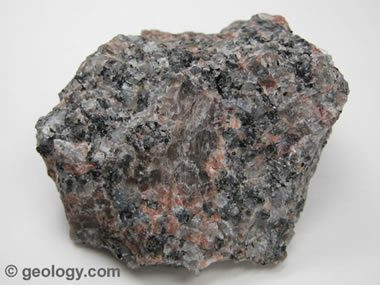 Coarse grained granite
Coarse grained granite
2. Who Uses Granite Rock?
Granite rock is used by a diverse group of people, including homeowners, landscape designers, architects, and construction professionals, due to its versatility and aesthetic appeal. Each group leverages granite for different purposes, reflecting its broad applicability.
- Homeowners: Utilize granite for kitchen countertops, bathroom vanities, flooring, and outdoor landscaping features.
- Landscape Designers: Incorporate granite into garden designs for pathways, retaining walls, and decorative rock features.
- Architects: Specify granite for building facades, interior wall cladding, and flooring in commercial and residential projects.
- Construction Professionals: Employ granite as a durable material for bridges, paving, and structural components.
These varied applications highlight granite’s adaptability and its role in both functional and aesthetic design, making it a staple in numerous industries.
3. Why is Granite Rock So Popular?
Granite rock is popular because of its durability, aesthetic appeal, and versatility, making it a preferred material for various applications. These qualities provide both practical and visual benefits that attract a wide range of users.
- Durability: Granite is highly resistant to weathering, abrasion, and chemical damage, ensuring longevity in both indoor and outdoor settings.
- Aesthetic Appeal: With a variety of colors and patterns, granite offers a timeless and elegant look that enhances any design.
- Versatility: Suitable for countertops, flooring, landscaping, and construction, granite’s adaptability makes it a valuable material for diverse projects.
- Low Maintenance: Granite surfaces are easy to clean and maintain, requiring minimal effort to keep them looking pristine.
- Increased Property Value: The use of granite in homes and commercial spaces adds value, signaling quality and sophistication.
These factors contribute to granite’s widespread popularity, making it a sought-after material in both residential and commercial projects.
4. What are the Geological Properties of Granite Rock?
Granite rock exhibits several key geological properties, including its coarse-grained texture, high compressive strength, and resistance to weathering, making it a durable and reliable material. These properties are fundamental to understanding granite’s suitability for various applications.
- Coarse-Grained Texture: Formed from slow cooling magma, granite has large, visible crystals that interlock, enhancing its strength.
- High Compressive Strength: Granite can withstand significant pressure, making it ideal for structural applications like building foundations and bridges.
- Resistance to Weathering: Granite’s mineral composition makes it resistant to chemical and physical weathering, ensuring long-term durability in outdoor environments.
- Low Porosity: Granite is relatively non-porous, which prevents water absorption and reduces the risk of cracking or staining.
- Thermal Resistance: Granite can withstand high temperatures without significant damage, making it suitable for kitchen countertops and fireplace surrounds.
Understanding these geological properties helps in appreciating why granite is a preferred material in construction and landscaping.
5. What is the Composition of Granite Rock?
Granite rock is primarily composed of quartz, feldspar, and minor amounts of mica and amphibole minerals, which determine its color and overall characteristics. The specific mineral composition can vary, leading to different types of granite with unique appearances.
- Quartz: Typically makes up 20-60% of granite, providing hardness and resistance to chemical weathering.
- Feldspar: Includes both plagioclase and alkali feldspar, constituting 35-65% of granite and influencing its color (pink, white, or gray).
- Mica: Such as biotite or muscovite, usually present in smaller amounts (3-10%), adding dark, flaky grains that contribute to the rock’s texture.
- Amphibole: Like hornblende, accounts for 2-15% of granite, adding dark, prismatic crystals that enhance its visual appeal.
- Other Minerals: May include trace amounts of magnetite, garnet, or zircon, contributing to variations in color and texture.
This diverse mineral composition is what gives granite its distinctive speckled appearance and contributes to its durability and aesthetic appeal.
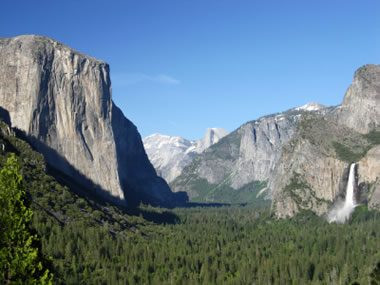 Granite in Yosemite Valley
Granite in Yosemite Valley
6. Where is Granite Rock Found?
Granite rock is found in continental landmasses around the world, particularly in the cores of mountain ranges and ancient shield regions, reflecting its formation deep within the Earth’s crust. Specific locations are known for their abundant and high-quality granite deposits.
- United States: Prominent granite quarries are located in states like Georgia, Massachusetts, New Hampshire, South Dakota, and Vermont.
- Brazil: A major exporter of granite, with significant deposits in regions like Espirito Santo and Minas Gerais.
- India: Known for its colorful granite varieties, particularly in states like Rajasthan, Andhra Pradesh, and Tamil Nadu.
- China: Has extensive granite resources, with quarries located in provinces like Shandong, Fujian, and Guangdong.
- Europe: Countries like Italy, Spain, and Norway also have significant granite deposits used for both local and international markets.
These locations are key sources of granite, supplying the global demand for construction, landscaping, and decorative applications.
7. How is Granite Rock Formed?
Granite rock is formed through a slow cooling process of magma deep beneath the Earth’s surface, allowing for the development of large, interlocking crystals. This process is crucial to granite’s characteristic texture and strength.
- Magma Generation: Molten rock (magma) forms in the Earth’s mantle or lower crust due to high temperatures and pressure.
- Intrusion: The magma rises through the crust, intruding into existing rock formations.
- Slow Cooling: Deep within the Earth, the magma cools very slowly over millions of years, allowing crystals of quartz, feldspar, and mica to grow large and interlock.
- Crystallization: As the magma cools, minerals crystallize out of the melt, forming the coarse-grained texture characteristic of granite.
- Uplift and Erosion: Over time, tectonic forces uplift the granite formations, and erosion removes the overlying rock layers, exposing the granite at the surface.
This slow, deep cooling process is what gives granite its distinctive appearance and exceptional durability, making it a valuable resource for various applications.
8. What are the Different Types of Granite Rock?
There are many types of granite rock, each distinguished by its unique color, mineral composition, and origin, providing a wide range of aesthetic options for various applications. The variations in granite types allow for tailored design choices that suit different preferences and project requirements.
| Type of Granite | Description | Common Uses |
|---|---|---|
| Uba Tuba | Dark green or black with flecks of gold, silver, or brown. | Countertops, flooring, landscaping. |
| Baltic Brown | Features brown and tan crystals with black accents. | Countertops, wall cladding, exterior paving. |
| Absolute Black | Uniformly black with a fine-grained texture. | Monuments, countertops, flooring. |
| White Ice | White and gray with swirling patterns, resembling ice floes. | Kitchen countertops, bathroom vanities, wall panels. |
| Santa Cecilia | Creamy background with burgundy, gold, and brown speckles. | Countertops, flooring, backsplashes. |
| Black Galaxy | Black with small, sparkling bronze or gold flecks. | Countertops, accent walls, fireplace surrounds. |
| Imperial White | Predominantly white with gray and beige patterns. | Kitchen islands, bathroom vanities, flooring. |
| Tan Brown | Dark brown with reddish-tan patterns. | Countertops, exterior cladding, landscaping features. |
| Blue Pearl | Iridescent blue and gray crystals. | Countertops, bar tops, accent walls. |
| Rosa Beta | Pinkish-gray with a uniform, speckled appearance. | Exterior paving, monuments, building facades. |
These various types of granite offer diverse aesthetic options, ensuring there is a suitable choice for any design project.
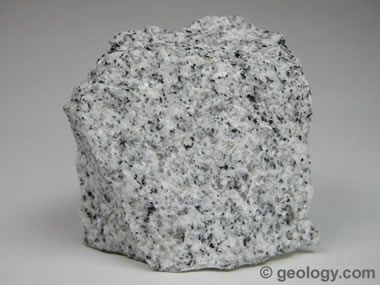 Fine-grained granite
Fine-grained granite
9. What are the Common Uses of Granite Rock?
Granite rock is used extensively in construction, landscaping, and interior design due to its durability, aesthetic appeal, and versatility. These applications highlight granite’s ability to enhance both the functionality and visual appeal of various projects.
- Countertops: A popular choice for kitchen and bathroom countertops due to its heat resistance, durability, and ease of maintenance.
- Flooring: Used in both residential and commercial buildings for its durability and elegant appearance.
- Landscaping: Employed for creating pathways, retaining walls, garden borders, and decorative rock features.
- Building Facades: Used as exterior cladding for buildings, providing a durable and aesthetically pleasing finish.
- Monuments and Memorials: A traditional material for creating lasting memorials due to its resistance to weathering.
- Paving: Used for sidewalks, driveways, and patios, offering a durable and attractive surface.
- Interior Design: Incorporated into fireplace surrounds, accent walls, and decorative elements, adding a touch of elegance to interior spaces.
Granite’s wide range of applications underscores its value as a versatile and high-quality material for both functional and decorative purposes.
10. How to Identify Granite Rock?
Identifying granite rock involves recognizing its key characteristics such as coarse-grained texture, visible crystals, and specific mineral composition. These visual and physical attributes make it distinguishable from other types of rocks.
- Coarse-Grained Texture: Look for large, easily visible crystals that are tightly interlocked.
- Mineral Composition: Identify the presence of quartz (clear or glassy), feldspar (pink, white, or gray), and mica (dark, flaky).
- Color: Granite typically has a light color, such as pink, white, gray, or a combination of these, often with dark speckles.
- Hardness: Granite is hard and durable, resistant to scratching with a steel knife.
- Location: Consider the geological context; granite is commonly found in mountainous regions or areas with exposed bedrock.
- Visual Inspection: Examine the rock closely under good lighting, using a hand lens if necessary, to identify the individual minerals and their arrangement.
By noting these characteristics, you can confidently identify granite rock, distinguishing it from other rock types commonly used in construction and landscaping.
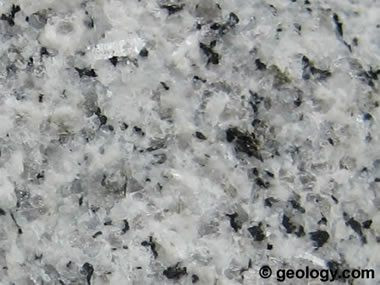 Granite close up
Granite close up
11. What are the Benefits of Using Granite Rock in Landscaping?
Using granite rock in landscaping offers numerous benefits, including durability, aesthetic appeal, and low maintenance, making it an excellent choice for enhancing outdoor spaces. These advantages provide both practical and visual enhancements to any landscape design.
- Durability: Granite is highly resistant to weathering, erosion, and physical damage, ensuring long-lasting beauty in outdoor environments.
- Aesthetic Appeal: With a variety of colors and textures, granite can create a natural and elegant look, complementing any landscape design.
- Low Maintenance: Granite requires minimal upkeep, resisting stains, fading, and the need for frequent cleaning.
- Versatility: Suitable for various landscaping applications, including pathways, retaining walls, water features, and decorative accents.
- Increased Property Value: Incorporating granite into landscaping can enhance property value by adding a touch of sophistication and quality.
- Natural Look: Granite blends seamlessly with natural surroundings, creating a cohesive and harmonious outdoor environment.
- Erosion Control: Granite boulders and rocks can help stabilize slopes and prevent soil erosion, promoting landscape stability.
These benefits make granite a preferred material for homeowners and landscape designers looking to create durable, attractive, and low-maintenance outdoor spaces.
12. What are the Environmental Considerations of Using Granite Rock?
Using granite rock involves several environmental considerations related to its extraction, processing, and transportation, which can impact ecosystems and contribute to carbon emissions. Awareness and responsible practices can help mitigate these effects.
- Quarrying Impacts: Granite extraction can disrupt local ecosystems, leading to habitat loss, soil erosion, and water pollution.
- Energy Consumption: Processing granite requires significant energy for cutting, polishing, and shaping, contributing to greenhouse gas emissions.
- Transportation Emissions: Transporting granite from quarries to distribution centers and construction sites involves heavy machinery and long distances, increasing carbon footprint.
- Waste Generation: Granite processing generates waste materials, including rock fragments and slurry, which need proper disposal to prevent environmental contamination.
- Water Usage: Quarrying and processing granite require substantial water resources, potentially straining local water supplies.
To mitigate these environmental impacts, consider the following practices:
- Source Responsibly: Choose granite from quarries that adhere to sustainable mining practices and environmental regulations.
- Recycle and Reuse: Utilize recycled granite products and reuse granite materials in landscaping and construction projects.
- Reduce Transportation Distances: Opt for locally sourced granite to minimize transportation emissions.
- Water Management: Implement water recycling systems in granite processing facilities to conserve water resources.
- Waste Management: Properly dispose of granite waste and explore opportunities for recycling and reuse in other applications.
By addressing these environmental considerations, the use of granite can be more sustainable and environmentally responsible.
13. How to Maintain Granite Rock in Landscaping?
Maintaining granite rock in landscaping involves simple yet effective practices to preserve its appearance and durability, ensuring it remains a beautiful feature of your outdoor space for years to come. Regular care and proper maintenance can prevent damage and keep granite looking its best.
- Regular Cleaning: Periodically rinse granite surfaces with water to remove dirt, debris, and organic matter.
- Mild Soap: Use a mild, non-abrasive soap for cleaning tougher stains, ensuring it doesn’t damage the granite’s surface.
- Avoid Harsh Chemicals: Refrain from using harsh chemicals, acids, or abrasive cleaners that can etch or discolor the granite.
- Sealing (Optional): Apply a sealant to granite surfaces, particularly countertops or frequently used areas, to protect against stains and water damage.
- Weed Control: Keep the surrounding areas free of weeds and vegetation that can stain or damage the granite.
- Proper Drainage: Ensure proper drainage around granite installations to prevent water accumulation and potential damage.
- Professional Inspection: Periodically inspect granite structures for cracks, chips, or other damage, addressing any issues promptly.
By following these maintenance tips, you can keep granite rock in your landscaping looking pristine and extend its lifespan, ensuring it remains a valuable and attractive feature of your outdoor environment.
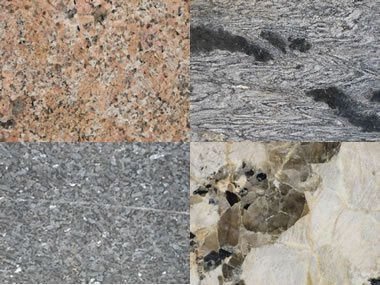 Rocks called granite by commercial industry
Rocks called granite by commercial industry
14. Frequently Asked Questions (FAQs) About Granite Rock
1. What is the difference between granite and marble?
Granite is an igneous rock composed mainly of quartz and feldspar, while marble is a metamorphic rock formed from limestone. Granite is harder and more resistant to scratches and acids than marble, making it suitable for high-traffic areas.
2. Is granite radioactive?
Some granite contains trace amounts of radioactive elements like uranium, thorium, and potassium. However, most granite used in countertops and construction poses no significant health risk. According to the EPA, granite countertops are generally safe.
3. How can I tell if a rock is granite?
Granite can be identified by its coarse-grained texture, visible crystals of quartz, feldspar, and mica, and its hardness. It is typically light-colored, such as pink, white, or gray, and resistant to scratching.
4. Is granite suitable for outdoor use?
Yes, granite is highly suitable for outdoor use due to its durability and resistance to weathering. It is commonly used for paving, retaining walls, landscaping, and building facades.
5. How do I clean granite countertops?
Granite countertops should be cleaned with a mild, non-abrasive soap and water solution. Avoid using harsh chemicals, acids, or abrasive cleaners that can damage the surface.
6. Can granite be sealed?
Yes, granite can be sealed to protect against stains and water damage, especially in areas like kitchen countertops. Sealing is optional but recommended for added protection.
7. What is the cost of granite?
The cost of granite varies depending on the type, color, and origin. Generally, granite ranges from $40 to $100 per square foot installed, making it a mid- to high-range material.
8. How does granite compare to other countertop materials like quartz?
Granite is a natural stone, while quartz countertops are engineered stone made from quartz crystals and resins. Granite is more porous and requires sealing, while quartz is non-porous and doesn’t need sealing. Both are durable, but quartz offers more consistent color and pattern options.
9. Can granite be recycled?
Yes, granite can be recycled and reused in various applications, such as crushed stone for road construction, landscaping fill, and aggregate in concrete.
10. What are the common finishes for granite surfaces?
Common finishes for granite surfaces include polished (glossy and reflective), honed (matte and smooth), and leathered (textured with a slight sheen). The choice of finish depends on the desired aesthetic and application.
Ready to elevate your landscape with the enduring beauty of granite? Visit rockscapes.net today for inspiration, expert advice, and a wide selection of granite options to suit your unique style and needs. Contact us at Address: 1151 S Forest Ave, Tempe, AZ 85281, United States. Phone: +1 (480) 965-9011, and let our team help you bring your vision to life.
